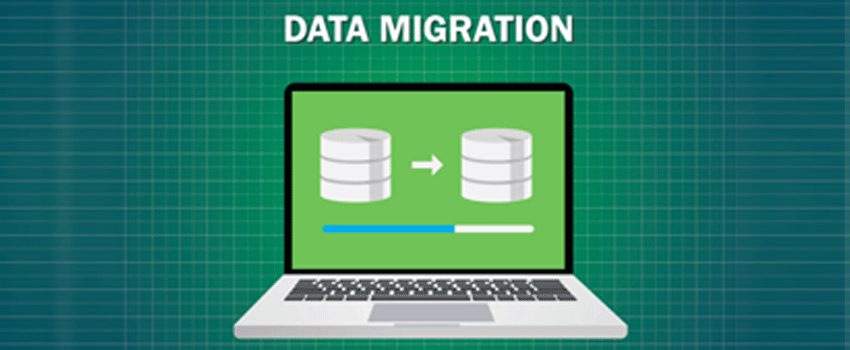The world has seen unprecedented growth in digital data over the past decade. Business crucial decision-making processes are now carried out using data analytics. But when large amounts of data have to be migrated from one system to another target system, companies often give less importance to the processes involved in data migration and end up making it a costly and time consuming activity.
In order to turn data migration into a cost-friendly and quick activity, there is a need to have a solid understanding of its basic concepts and processes flow. This is what you are going to learn in this blog. But if you are already well aware of the basics of data migration, then you can jump into the processes section to learn about the step-by-step approach on how to handle data migration projects efficiently.
What is Data Migration
Data migration is the process of transferring data from one computing environment or storage system to another. Basically, it involves selecting, extracting, and transferring data from one format to another, one location to another, or one application to another.
Companies conduct data migration for many reasons, such as upgrading the entire storage system, upgrading databases, setting up new data warehouses, merger and acquisition (M&A) activities, etc. In addition, the data migration process is also a crucial activity when shifting from on-premises infrastructure to the cloud environment. Whatever case triggers the need for data migration, every company needs a cost-effective, secure, and efficient data migration procedure to achieve the desired objectives with no to minimal disruption.
But don’t confuse data migration with data integration. Integration is the process of gathering data from different sources within and outside the company to make it accessible from a single place. So, it is more like a data management practice that helps in getting continuous real-time data access and sharing support. On the other hand, data migration involves moving selected data from one place to another in a one-way journey.
Types of Data Migration
Before we turn our focus on the data migration process, let’s have a brief and quick look at the 6 common types of data migration:
- Storage Migration
When a company plans to upgrade its storage equipment to advanced ones, then this type of data migration is termed storage migration. In such a migration, data is transferred from one storage medium to another. For example, a company might be upgrading from tapes to HDD, from HDD to SSD, or from on-premises to the cloud.
- Application Migration
Application migration is called when a company is shifting to new application software or a new vendor. Therefore, data is migrated from one application platform to another. It can become a challenging process if the target application has different data formats and data models.
- Data Center Migration
Data center migration involves either migrating data from one data center infrastructure to new updated data center infrastructure in the same physical location or migrating data center infrastructure to a new physical location.
- Database Migration
Databases help in structuring data into organized formats that are managed by database management systems (DBMS). Therefore, database migration is a process of migrating data from one DBMS to its updated version or a new DBMS.
- Business Process Migration
Business process migration involves the process of transferring business processes, data, and applications to a new environment. Such data sets usually include product, customer, and operational data. This migration is called during mergers and acquisitions (M&A), reorganization, or business optimization.
- Cloud Migration
Probably one of the trending data migration types, cloud migration involves moving data from on-premises infrastructure to the cloud computing environment. It requires a subscription with a cloud services provider and then migrating data to the cloud while ensuring data security.
Process of Data Migration
Having clear insights on the data migration process can save significant time and money for any company. Following are the main stages from which every data migration project should flow gradually:
- Planning
Data migration should start with proper planning because migrating data efficiently is a crucial and complex process, thereby demands a proper data migration plan. There are multiple stages involved in planning, such as setting up the scope of migration, assessing both source and target systems, setting data standards, setting project timeframe, and estimating the budget. With proper planning, the migration team gets a clear path to proceed.
- Data Auditing and Profiling
The data auditing and profiling phase involve a thorough analysis and cleaning of data that is to be migrated. It involves eliminating duplicates, pinpointing data quality issues, identifying conflicts, and similar other issues in the data.
This stage becomes time-consuming and hectic if there is a ton of data to migrate. Therefore, companies can opt for automation tools that can perform data auditing and profiling in minimal time with utmost accuracy.
- Data Backup
As an added layer of data protection, making a complete data backup of all the data that is planned to be migrated is highly recommended. It’s not a mandatory step, but if you are migrating sensitive data, then data backup prevents data loss possibility.
- Migration Design
The migration design stage involves setting up migration rules, testing framework, acceptance standards, and assigning responsibilities among the data migration management team.
Data migration can be conducted using different technologies, but the recommended one is ETL (extract, transform, and load). If you opt for ETL technology, then it’s better to hire an ETL specialist or a software engineer skilled in handling ETL processes. An ETL specialist will create scripts for ETL procedures during the migration design stage and set up third-party ETL automation tools.
- Execution
Execution is the stage of actual data migration where you will initiate data extraction and transfer. This stage can take a few days if all data is planned to migrate at once or can take extra time if you have planned to migrate data in phases.
- Testing Data Migration
Testing is crucial to ensure that all the data migration procedures are working as planned, while the malfunctions can be fixed timely. You don’t have to consider testing a separate or one-time process because it is continuously conducted during the planning, designing, and executing stages.
- Post-Migration Audit
Once the migration is executed, there should be a thorough post migration audit where users and other personnel can validate that the data is migrated correctly and completely. Once you finish this stage, your migration is successfully completed.
Wrapping Up
Data migration is a common activity that companies have to conduct after a certain period of time. But it has become more common with the rapid advancement in technology and the shift towards digital transformation. Therefore, the best approach to handle data migration projects is to ensure that migration team members are well-educated and gradually proceed with the process by following the above-mentioned migration stages.
https://backupeverything.co.uk/what-is-data-migration-its-types-and-processes/




